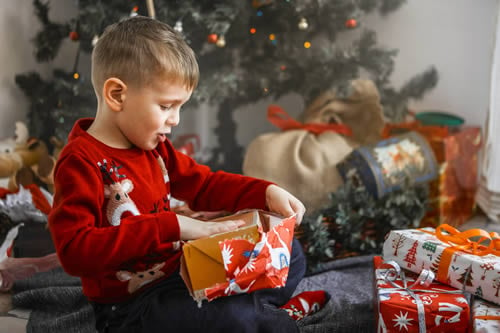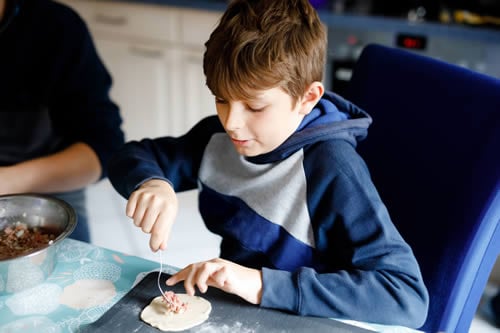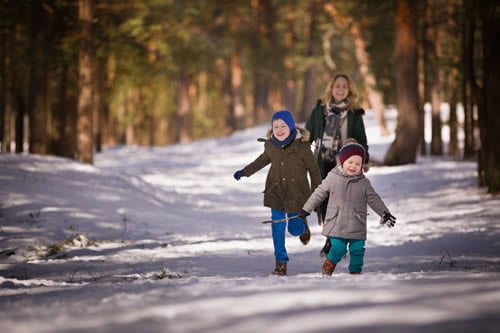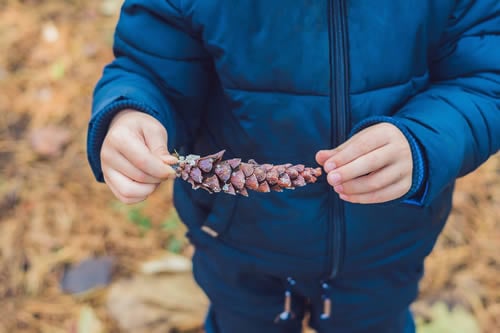As most people who work in education will tell you, it’s important to grab ‘real life’ opportunities to consolidate what children learn in the classroom. Even better, they say, if you can make these activities enjoyable so that kids don’t even realise they are polishing their skills.
SEN Tutor Kelly has more than fifteen years’ experience working with SEN. She says that the Festive Season is a fantastic time for all kinds of creative projects which can gently boost children with a wide range of special needs.
“You can take some twinkly lights and create a sensory environment for a child – in a tent or a dark room or even by draping a sheet over a couple of chairs,” she says. “Another sensory activity is to mix cornflour and water on a tray and call it ‘snow’. It’s interesting to touch – it feels solid if you tap it but it’s still a liquid if you run it through your fingers.”
Christmas Presents

Christmas gifts wrapped in crinkly, shiny paper also provide sensory stimulation but, Kelly continues, you can boost children’s fine motor skills by getting them to wrap the presents and turn it into a game by timing the activity. Large motor skills can be brought into play by getting children to carry parcels to the tree and arrange them underneath. For children who are non-verbal, she suggests putting wrapped presents in a sack and taking them out one-by-one. Here, the game is to guess which colour comes out next by pointing to a corresponding card.
“For children with autism, gift-giving can also be an opportunity to develop social understanding,” she continues. “You can discuss, for example, how we only open our own presents and how people might feel when they open their gifts. You can role play people’s facial expressions and talk about what we expect them to say such as ‘thanks’ and ‘you’re welcome’.”
Mince Pies and Santa Claus

Christmas baking is another multi-faceted activity, Kelly points out. Children who struggle with numbers can practise weighing and measuring ingredients, she says, while those who need help with words can try reading the instructions. To ramp up the fun-factor, she suggests youngsters can practise communicating by pretending they are presenting a cookery programme.
“We know that writing with a purpose is more stimulating for children who find handwriting difficult,” she advises. “Encourage them to make and write Christmas cards or write a letter to Santa.”
The Steiner Approach

Qualified teacher and SENCO Steve has been working with children with special needs for a number of years and recently took up a position at a Steiner school. He points out that Christmas can sometimes be very stressful and over-stimulating for adults and children alike, with parents often feeling pressured to buy loads of plastic toys and lay on endless fun activities.
In contrast, the Steiner approach, he says, is all about embracing nature and the seasons. “Winter is viewed as a time to go slow so parents could take the Christmas holidays as an opportunity to spend quality time with their kids, rather than rushing around. That’s just as beneficial to a child’s development as pushing them to do worksheets or play educational games. I’ve seen how calming this can be for children – especially those with special needs.”
Spending time outdoors in the natural world – even in a park or a garden if you live in a town – allows children to get fresh air and daylight and move around, he says, but also provides gentle opportunities for learning.
Using Found Objects

“The children can use what they find while they’re out and about,” Steve continues. “Get them to collect things like pinecones, twigs, pebbles or shells. They could use these for counting, learning about odd and even numbers or creating sets of ten, for example. They can also take these items home to create artwork. The important thing is to follow the child’s lead.”
In a similar way, he points out, parents can encourage kids to do arts and crafts by making something themselves. The key is allowing children to observe what you’re doing without forcing them to take part. Encouraging their curiosity, he says, will hopefully prompt them to join in.
“I’m not a qualified Steiner teacher myself,” Steve points out, “but I’m very interested in the approach. It really seems to enhance emotional-regulation, focus and learning with the whole body”.




